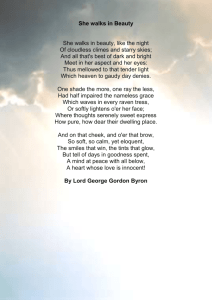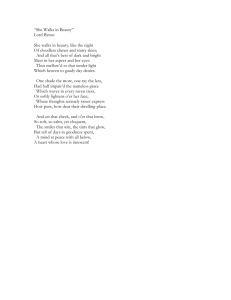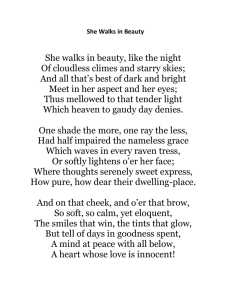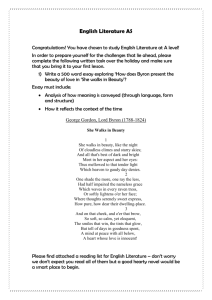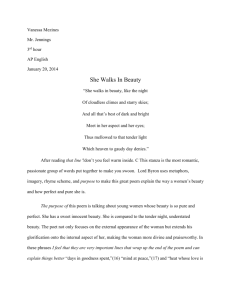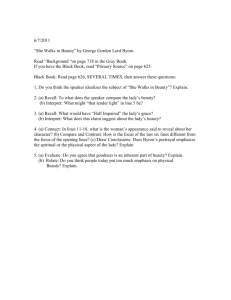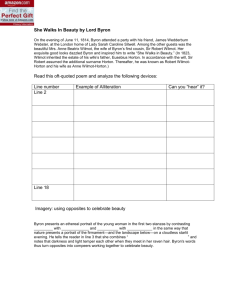Lord Byron - lovelearners
advertisement
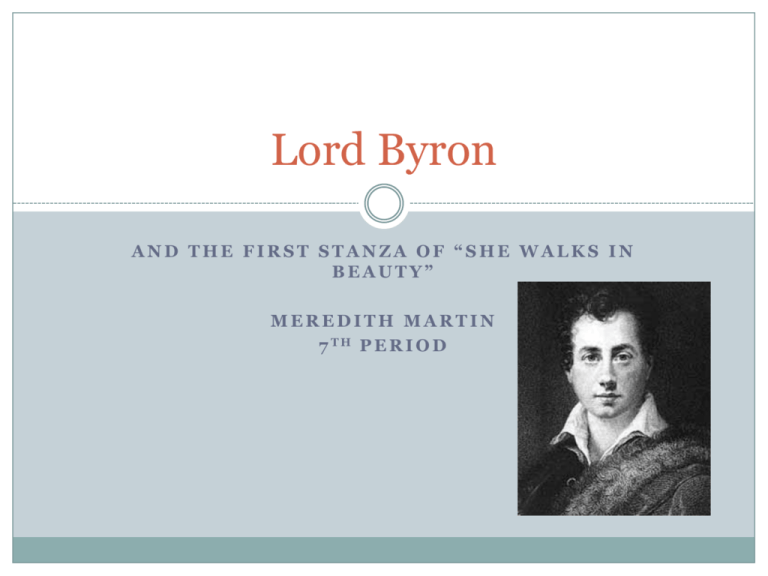
Lord Byron AND THE FIRST STANZA OF “SHE WALKS IN BEAUTY” MEREDITH MARTIN 7 TH P E R I O D Lord George Gordon Byron’s Biography 1788 – 1824 Handsome and daring figure in literary history Born into family of soldiers, seamen, and fighters Born with a club leg, gave him a limp, had to prove himself physically through sports Dare-devil personality At 10 years old, inherited the estate of his great-uncle and the title of sixth Baron Byron Fame came from publishing Childe Harold’s Pilgrimage Biography Continued Lived a reckless and dissipated lifestyle which to debts and depression Also had many romantic relationships, but only one marriage Rumors about Byron provoked him into leaving England and moving to Switzerland and then later Italy His masterpiece, Don Juan, was written while he was in Italy Went to help Greece in their war against Turkish rule, but well he was in training he caught a fever and died National hero in Greece for his dedication to the country’s revolution Background Byron was the most popular poet during the romantic period The heroes of his poems were “rebellious, moody people of great passion and strong will” Byron was the ideal example of the romantic spirit His poetry was rooted in 18th-century forms, no experimentation His journeys to Portugal, Spain, Malta, Greece, and Asia Minor inspired his work Childe Harold’s Pilgrimage Stanza one of “She Walks in Beauty” She walks in beauty, like the night Of cloudless climes and starry skies; And all that's best of dark and bright Meet in her aspect and her eyes: Thus mellowed to that tender light Which heaven to gaudy day denies. Lines 1-2: The woman is as beautiful as a cloudless, starry night sky Lines 3-4: the woman’s eyes and face combine the opposites of darkness and light, her face is able to combine opposite things together to form something beautiful Lines 5-6: emphasizes the contrast the woman’s beauty contains - Light and darkness is evident in the first stanza to show how beauty contains aspects which are light and bright while other aspects which are dark and more effort is needed to see them Characteristics of Romanticism Love of Nature “She walks in beauty, like the night/Of cloudless chimes and starry skies” Idealism “And all that’s best of dark and bright/Meet in her aspect and her eyes” Poetic Devices Rhyme scheme: ABABAB Meter: tetrameter iambic Lines 1 and 2 contain an enjambment (no pause between lines) Alliteration in line 2 (cloudless chimes & starry skies) and line 6 (day denies) Smile in line 1-2 (compares woman’s beauty to “like the night/Of cloudless climes and starry skies”) Bibliography The Language of Literature: British Literature. Evanston, Ill.: McDougal Littell, 2000. Print. pages 773-774 and 780 http://mural.uv.es/bosmarmi/shewalksinBeauty.ht ml http://www.cummingsstudyguides.net/Guides5/She Walks.html Picture of Lord Byron: http://www.loyno.edu/~etc/images/lord-byron.JPG
